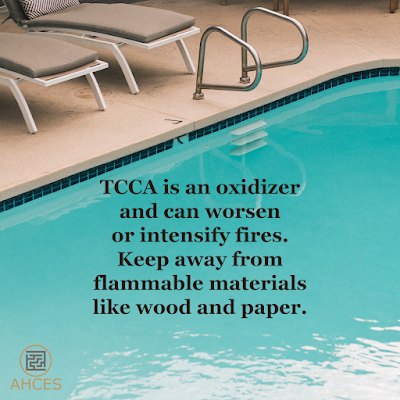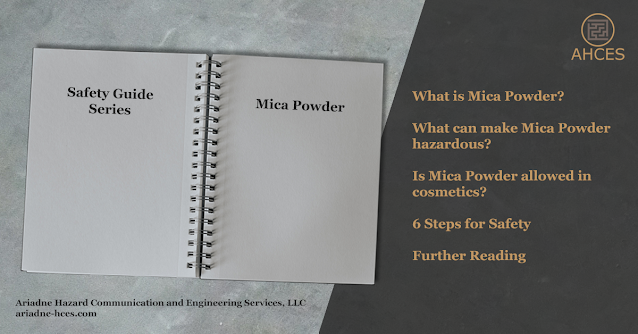TCCA Safety Guide
What is TCCA?
Since TCCA is used as a germicide and fungicide in the treatment of water, it is regulated as a pesticide by the EPA and has the associated labeling and disposal requirements.
TCCA has the CAS Number 87-90-1.
The CAS Number is used to identify TCCA as an ingredient on safety data sheets (SDS) and other safety documentation. When looking for TCCA as an ingredient in pool cleaners, dry bleach, or other products, look for the CAS Number within the composition table.
Notable Properties of TCCA
TCCA is a white crystalline solid with a halogen odor. When in water, TCCA releases hypochlorous acid. Hypochlorous acid is the active disinfecting component used for water treatment and other cleaning purposes.
What Makes TCCA Hazardous?
TCCA has several associated hazards, being an oxidizer, an irritant, and hazardous to the environment. Different risks come from each of the different hazardous properties of TCCA.
As an oxidizer, TCCA creates a fire risk by having the potential to worsen or intensify fires. Accordingly, TCCA should not be kept near flammable materials, such as wood or paper.
TCCA can be hazardous to human health as an irritant. TCCA can cause damage to the skin and eyes, as well as being harmful if swallowed.
The same germicide and fungicide properties that make TCCA an excellent pool cleaner make it an environmental hazard as it can harm wildlife.
6 Steps for Safety
Step 1: Read the Warnings
When working with a product for the first time, always read all the safety documents first. This includes safety data sheets, which should be provided by the manufacturer or importer of the TCCA product. There may also be an EPA pesticide label, OSHA chemical label, or a Consumer Protection label on the packaging of the TCCA product. These documents all contain important information on the hazards of the product and instructions on how to mitigate those hazards.
Different compositions in different products may cause additional hazards to be present beyond the properties of a product with TCCA as the only active ingredient. Be sure to familiarize yourself with the differences between separate TCCA-based products.
Step 2: Prepare Your Workspace
Creating a safe workspace, sometimes referred to as engineering control, is a key component of working safely with any potentially hazardous substance.
One of the primary routes of exposure for TCCA is contact with airborne dust, which can then enter the airways or eyes and cause chemical burns. Fans that would blow BCDMH dust around should be avoided. Dust collectors and air filters which draw in and capture any stray TCCA dust are ideal.
Step 3: Gather Your PPE
- Respiratory Protection
- A respirator rated to handle organic vapors and/or halogens is recommended.
- A full-facepiece respirator can serve as both respiratory protection and eye protection.
- Eye and Face Protection
- Safety goggles which create a seal around the eyes are needed to prevent any airborne TCCA from reaching the eyes.
- Open safety glasses, which do not have a sealing surface, will not work in preventing dust from reaching the eyes. A face shield can be used in combination with safety glasses.
- Gloves
- Rubber gloves will prevent TCCA from touching the skin on the hands and causing irritation.
- As TCCA is corrosive, be sure to use gloves that are resistant to corrosive substances.
- Long Sleeves
- Long sleeves will prevent TCCA from touching the skin on the arms and causing irritation.
- Either a long-sleeved shirt, long-sleeved coat, or disposable sleeves will work.
- Launder any contaminated closing separately to prevent cross-contamination and inform anyone laundering the clothing of the presence of TCCA so they can take any necessary precautions.
Step 4: Clear Your Workspace
Having a clear workspace is an important part of safety. Clutter can cause accidents and can prevent you from noticing if something has spilled.
This is also a good time to double-check check any engineering controls, like a dust collector, are in proper working order and no filters need to be changed out.
If you are working in a shared space, make sure anyone around you can also remain safe when you are working with TCCA. For those working at home, this can include family members and pets.
Step 5: Do The Work
TCCA has a fire risk due to being an oxidizer. Ensure that proper fire safety precautions are in place in the work area.
If PPE and good work practices are used properly, working with TCCA has minimal hazards.
If work cannot be completed in one sitting, be sure to properly seal any TCCA containers to prevent spills or accidental release when not in use.
Step 6: Clean Up
Use large volumes of water to clean up any spilled TCCA to dilute the resulting solution. Be sure to dispose of any waste in accordance with local regulations.
As TCCA is an environmentally hazardous substance, take extra precautions so that none is released into the environment during cleanup.
Further Reading
The National Library of Medicine has a PubChem Entry on TCCA and Hazardous Substances Data Bank Entry.
Check out the Safety Guide Series Hub for more safety guides.
Sources Cited
National Center for Biotechnology Information (2024). PubChem Compound Summary for CID 6909, Trichloroisocyanuric acid. Retrieved April 29, 2023 from https://pubchem.ncbi.nlm.nih.gov/compound/Trichloroisocyanuric-acid.
National Center for Biotechnology Information (2024). PubChem Annotation Record for , Trichloroisocyanuric acid, Source: Hazardous Substances Data Bank (HSDB). Retrieved April 29, 2023 from https://pubchem.ncbi.nlm.nih.gov.
Original Posting Date: Aprl. 26, 2023
Last Updated: Feb. 12, 2024






Comments
Post a Comment